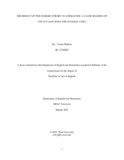The impact of iceberg theory in literature: a close reading of the Sun also rises and invisible cities

View/
Date
2021-01Publisher
Brac UniversityAuthor
Shahrin, TasniaMetadata
Show full item recordAbstract
In Ernest Hemingway’s novels and short stories the priority to narrate the plot was evenly distributed between the content as well as the style of the writing. In a nutshell, he used a special
writing style to hint at the inner meaning and purpose of the novel – without actually writing it
out alphabetically. This unique style of Hemingway is widely known as the Iceberg theory. The
purpose of this theory then becomes, to motivate the readers to through apparent surfaces into
layers of possible ‘truths’ and subtexts as they repeatedly read the same work through multiple
perspectives. Even though this theory is closely related to Hemingway’s prose, other famous
authors around the world, such as Italian writer Italo Calvino, Japanese contemporary writer
Haruki Murakami etc. also applied this device to narrate their fictions. In this paper, a close
reading and in-depth analysis will be given to two novels by Ernest Hemingway and Italo
Calvino. Their novels The Sun also Rises and Invisible Cities master the concept of deferring
underlying signification or meaning to hindsight for the readers to decipher. The reason this topic
is given a form of research in this paper is to show how the Iceberg theory serves the readers a
unique writing style separate from other potentially relevant theories such as intertextuality,
heteroglossia and polyphony that not only holds a beautiful narrative to meet the thirst of the
eyes but also several layers of philosophical truths that satisfy the needs of the mind.
Keywords
LC Subject Headings
Hemingway, Ernest, 1899-1961--FictionDescription
This thesis is submitted in partial fulfillment of the requirements for the degree of Bachelor of Arts in English, 2021.Department
Department of English and Humanities, Brac UniversityType
ThesisCollections
- Thesis, B.A. (English) [621]
